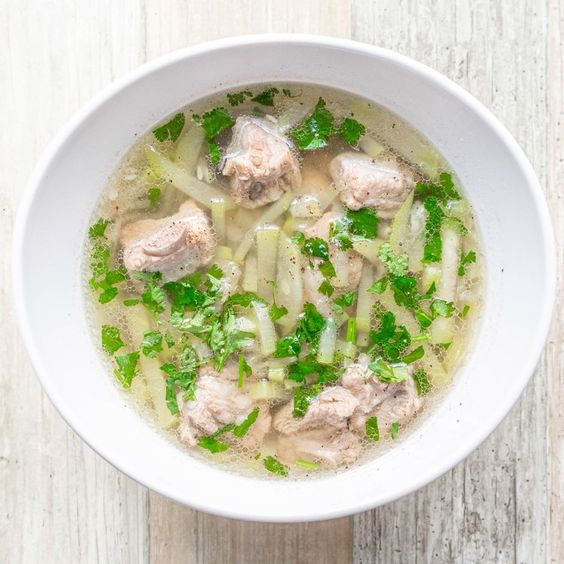When it comes to Vietnamese cuisine, most people think of pho, banh mi, or even the iconic spring rolls. But delve a little deeper, and you’ll find hidden culinary gems like canh bí đao – a refreshing, light, and simple Vietnamese soup made from winter melon. This dish might not have the global fame of its counterparts, but for locals, especially in the sweltering heat of Vietnam, it’s a daily staple. So what exactly is canh bí đao, and why is it beloved by so many?
Table of Contents
Canh Bí Đao: The Basics
Canh bí đao (winter melon soup) is a simple yet versatile Vietnamese soup that uses bí đao, or winter melon, as its primary ingredient. The soup is commonly made by boiling chunks of winter melon in a clear broth, which is usually seasoned with fish sauce and garnished with green onions or cilantro. Proteins such as minced pork, shrimp, or even fish can be added to make it a heartier dish.

Winter melon, known for its high water content and mild flavor, is perfect for light and cooling soups like canh bí đao, which is commonly served as part of a family meal. It’s one of those dishes that defines Vietnamese home-cooking—light on the stomach, refreshing on a hot day, and nourishing without being heavy.
Click the link for best Pho in Saigon.
A Brief History of Winter Melon in Vietnamese Cuisine
Winter melon (bí đao), also called ash gourd or wax gourd, is native to Southeast Asia and has long been a staple in Vietnamese kitchens. This versatile vegetable is particularly appreciated for its cooling properties, which makes it ideal for combating the country’s tropical climate. Used in both soups and stir-fries, bí đao is one of those ingredients that seamlessly fits into many traditional Vietnamese dishes.
In traditional Eastern medicine, winter melon is known for its cooling properties, which is why canh bí đao is a popular dish in Vietnam, especially during the sweltering summer months. The Chinese influence on Vietnamese cuisine is apparent here, as winter melon soups are also common in Chinese cooking. However, the Vietnamese version is lighter and uses local ingredients like fish sauce for seasoning, giving it a distinct flavor profile.
To read about Cambodian cuisine click here.

How to Make Canh Bí Đao
Though the recipe can vary from region to region and household to household, the essence of canh bí đao remains the same. Here’s a basic version of how you can make this refreshing soup:
Ingredients:
- 500g winter melon (bí đao)
- 200g minced pork or shrimp (optional for added protein)
- 1 liter of chicken or pork broth (or water for a lighter soup)
- 1 tablespoon of fish sauce
- A pinch of sugar (optional)
- A handful of chopped green onions or cilantro for garnish
- Salt and pepper to taste
Instructions:
- Prepare the winter melon: Peel the winter melon, remove the seeds, and chop it into bite-sized cubes.
- Cook the protein: If using minced pork or shrimp, sauté it in a pot with a bit of oil until lightly browned. Season with salt and pepper.
- Make the broth: Add the chicken or pork broth to the pot (or water if you want a lighter soup). Bring the liquid to a boil.
- Add the winter melon: Once the broth is boiling, add the winter melon cubes. Let it cook for about 10 minutes or until the melon becomes tender.
- Season and garnish: Add fish sauce, a pinch of sugar (if desired), and salt and pepper to taste. Garnish with chopped green onions or cilantro before serving.
And there you have it—an easy-to-make dish that captures the simplicity of Vietnamese cooking while delivering maximum refreshment and comfort.
To read our guide to Phu Quoc click here.
The Health Benefits of Winter Melon
Not only is canh bí đao delicious, but it also packs a punch when it comes to health benefits. Winter melon is low in calories but high in water content, making it an excellent choice for hydration. It’s also a good source of vitamins C and B, along with essential minerals like potassium, magnesium, and calcium.
In traditional Vietnamese and Chinese medicine, winter melon is valued for its diuretic properties, meaning it can help reduce water retention and improve kidney function. The melon is also believed to aid digestion, making it a go-to ingredient when you’re feeling under the weather or trying to detox.
Best Places to Try Canh Bí Đao
While canh bí đao is a common dish in Vietnamese homes, it’s also available at many local eateries, especially those that specialize in com gia dinh (family-style meals). Here are some top places where you can try this refreshing soup:
- Cơm Nhà Quê (Hanoi): Known for its authentic Vietnamese home-cooked meals, this place is perfect for those wanting to experience canh bí đao in a cozy setting.
- Bếp Nhà Lục Tỉnh (Ho Chi Minh City): Located in the heart of Saigon, this restaurant focuses on traditional southern Vietnamese food, and their winter melon soup is a must-try.
- Cơm Niêu Sài Gòn (Ho Chi Minh City): A popular spot for both locals and tourists, where family-style meals include refreshing soups like canh bí đao.
- Home Cooked Saigon (Ho Chi Minh City): This spot offers a great introduction to Vietnamese family meals, including their light and refreshing canh bí đao.
Conclusion
Canh bí đao may not be the flashiest dish in Vietnamese cuisine, but its simplicity is its charm. The mild flavor of the winter melon, combined with a light, fragrant broth, creates a soup that’s not only delicious but also deeply nourishing. Whether you’re looking to cool down on a hot day or just want a comforting bowl of soup, canh bí đao is the ultimate Vietnamese hidden gem—both for its taste and its health benefits.
To check out my Vietnam tours click here.

